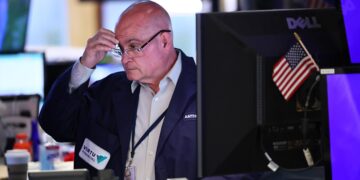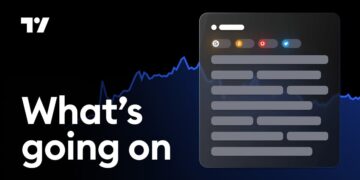
U.S. stocks ended mixed Wednesday as investors weighed fresh gains in tech against caution from the Federal Reserve and ongoing concerns about inflation. The S&P 500 (^GSPC) ended flat at 6,092.16, the Nasdaq Composite (^IXIC) edged up 0.31%, and the Dow Jones Industrial Average (^DJI) slipped 0.25%, losing more than 100 points.
The market’s mood was shaped largely by Fed Chair Jerome Powell’s congressional testimony and a record-breaking rally in Nvidia (NVDA), which jumped 4.3% to close at $154.31 — its highest ever. The chipmaker’s surge helped prop up the tech-heavy Nasdaq, even as concerns about trade tariffs and inflation loomed over broader indices.
Nvidia powers Nasdaq to gains
Nvidia once again stole the spotlight. Its shares rallied on Wednesday after Loop Capital raised its price target to $250, citing the company’s dominant position in the AI chip space and expectations of a $2 trillion AI market by 2028. Nvidia’s current valuation near $3.6 trillion makes it one of the most valuable companies globally.
The chipmaker’s rally came amid strong momentum in the broader tech sector. The Technology Select Sector SPDR Fund (XLK) gained 0.85% and has now outperformed the broader S&P 500 and the Magnificent Seven ETF (MAGS) for the month.
Micron (MU) also remains in focus as it prepares to report earnings. Despite a slight dip ahead of the release, Micron is up 50% for the year, bolstered by robust demand for AI-related memory chips.
Powell cautious on rate cuts
Federal Reserve Chair Jerome Powell struck a balanced tone in his second day of testimony before Congress. While reiterating that the Fed remains data-dependent, Powell warned that tariffs imposed by the Trump administration could fuel inflation “over the coming months.”
“There will be some inflation from tariffs coming, not yet, but over the course of the coming months,” Powell said, adding that the Fed would need to “wait and see” how this develops before cutting interest rates.
These remarks dampened hopes that rate cuts might come as early as July, though investors still expect some easing before year-end. Swaps markets are now pricing in 60 basis points of cuts by December.
Market near record highs — but can it last?
The S&P 500 remains less than 1% away from its all-time high. After a turbulent spring driven by Trump’s surprise tariffs, the index has clawed back losses, gaining over 3% year-to-date. The Nasdaq 100, meanwhile, has already posted a new record high this week.
Still, some analysts urge caution. “The market is looking through some of the present and clear risks associated with tariffs,” said Keith Buchanan, senior portfolio manager at Globalt Investments. “It can do that in an irrational way.”
The biggest wildcards? Inflation, earnings, and geopolitics. With second-quarter earnings season set to begin in mid-July, Wall Street will soon get a clearer picture of how companies are managing rising costs and uncertain demand.
Investors eye Friday’s PCE inflation report
Attention now shifts to Friday’s release of the Fed’s preferred inflation measure — the Personal Consumption Expenditures (PCE) index. Economists expect May’s “core” PCE, which strips out food and energy, to show a slight uptick from April.
Markets will scrutinize the data for clues on whether inflationary pressures — especially those linked to tariffs — are building. Any surprises could reshape expectations for Fed policy and spark volatility in bond and equity markets alike.
Other movers: Reddit, BP, Campbell’s, Coinbase
Beyond the major indices, Reddit (RDDT) continued its rally, gaining another 5% after a 40% monthly climb. Analysts credited its AI integration efforts and growing advertiser interest despite algorithm shifts from Google.
BP (BP) surged 8% on reports of early acquisition talks with Shell (SHEL), a potential $80 billion deal that would reshape the global energy landscape.
Campbell’s (CPB) fell over 3%, hitting its lowest level since 2012 amid ongoing weakness in its snack business and the death of its largest shareholder.
Coinbase (COIN) gained 3% after analysts called it the “Amazon of crypto,” citing growth in its Prime lending desk, blockchain services, and institutional offerings.
Outlook: What’s next for markets?
Looking ahead, investors will continue to monitor Powell’s remarks, tariff developments, and geopolitical tensions in the Middle East. A U.S.-brokered ceasefire between Israel and Iran appears to be holding — a factor that has eased oil market tensions and added stability to global markets.
However, the path forward remains uncertain. As Mohit Kumar of Jefferies noted, “We are not looking for a massive rally from current levels, but believe that the path of least resistance is a grind higher.”
The combination of resilient tech leadership, cautious optimism on rate cuts, and steady earnings could support stocks in the near term. But if inflation reaccelerates or political tensions flare, volatility could return swiftly.
Final word
The market’s summer rally faces key tests in the coming weeks — from inflation data to earnings and political maneuvering. Investors appear to be cautiously optimistic, but plenty of variables remain. As always, staying diversified and focused on long-term fundamentals is the best defense in uncertain times.





















